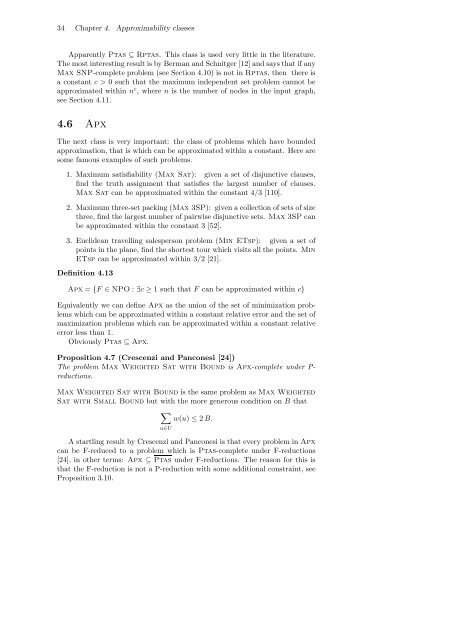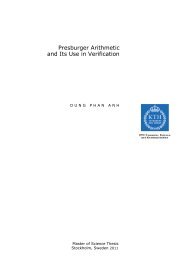On the Approximability of NP-complete Optimization Problems
On the Approximability of NP-complete Optimization Problems
On the Approximability of NP-complete Optimization Problems
Create successful ePaper yourself
Turn your PDF publications into a flip-book with our unique Google optimized e-Paper software.
34 Chapter 4. <strong>Approximability</strong> classes<br />
Apparently Ptas ⊆ Rptas. This class is used very little in <strong>the</strong> literature.<br />
The most interesting result is by Berman and Schnitger [12] and says that if any<br />
Max S<strong>NP</strong>-<strong>complete</strong> problem (see Section 4.10) is not in Rptas, <strong>the</strong>n <strong>the</strong>re is<br />
a constant c>0 such that <strong>the</strong> maximum independent set problem cannot be<br />
approximated within n c ,wheren is <strong>the</strong> number <strong>of</strong> nodes in <strong>the</strong> input graph,<br />
see Section 4.11.<br />
4.6 Apx<br />
The next class is very important: <strong>the</strong> class <strong>of</strong> problems which have bounded<br />
approximation, that is which can be approximated within a constant. Here are<br />
some famous examples <strong>of</strong> such problems.<br />
1. Maximum satisfiability (Max Sat): given a set <strong>of</strong> disjunctive clauses,<br />
find <strong>the</strong> truth assignment that satisfies <strong>the</strong> largest number <strong>of</strong> clauses.<br />
Max Sat can be approximated within <strong>the</strong> constant 4/3 [110].<br />
2. Maximum three-set packing (Max 3SP): given a collection <strong>of</strong> sets <strong>of</strong> size<br />
three, find <strong>the</strong> largest number <strong>of</strong> pairwise disjunctive sets. Max 3SP can<br />
be approximated within <strong>the</strong> constant 3 [52].<br />
3. Euclidean travelling salesperson problem (Min ETsp): given a set <strong>of</strong><br />
points in <strong>the</strong> plane, find <strong>the</strong> shortest tour which visits all <strong>the</strong> points. Min<br />
ETsp can be approximated within 3/2[21].<br />
Definition 4.13<br />
Apx = {F ∈ <strong>NP</strong>O : ∃c ≥ 1 such that F can be approximated within c}<br />
Equivalently we can define Apx as <strong>the</strong> union <strong>of</strong> <strong>the</strong> set <strong>of</strong> minimization problems<br />
which can be approximated within a constant relative error and <strong>the</strong> set <strong>of</strong><br />
maximization problems which can be approximated within a constant relative<br />
error less than 1.<br />
Obviously Ptas ⊆ Apx.<br />
Proposition 4.7 (Crescenzi and Panconesi [24])<br />
The problem Max Weighted Sat with Bound is Apx-<strong>complete</strong> under Preductions.<br />
Max Weighted Sat with Bound is<strong>the</strong>sameproblemasMax Weighted<br />
Sat with Small Bound but with <strong>the</strong> more generous condition on B that<br />
<br />
w(u) ≤ 2 B.<br />
u∈U<br />
A startling result by Crescenzi and Panconesi is that every problem in Apx<br />
can be F-reduced to a problem which is Ptas-<strong>complete</strong> under F-reductions<br />
[24], in o<strong>the</strong>r terms: Apx ⊆ Ptas under F-reductions. The reason for this is<br />
that <strong>the</strong> F-reduction is not a P-reduction with some additional constraint, see<br />
Proposition 3.10.

















